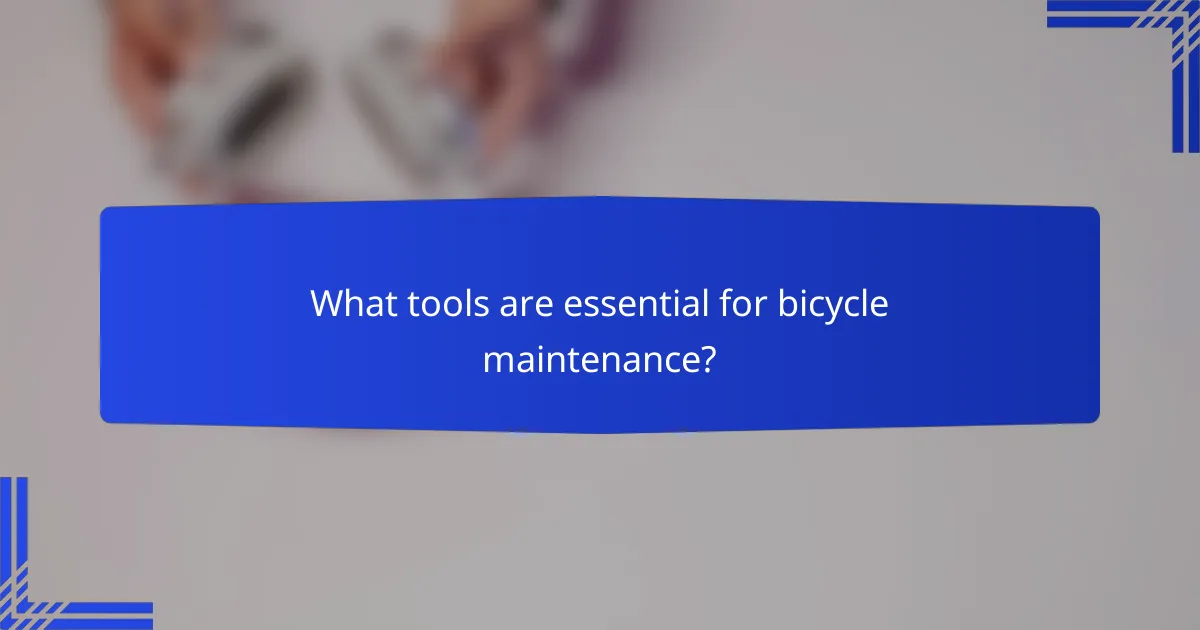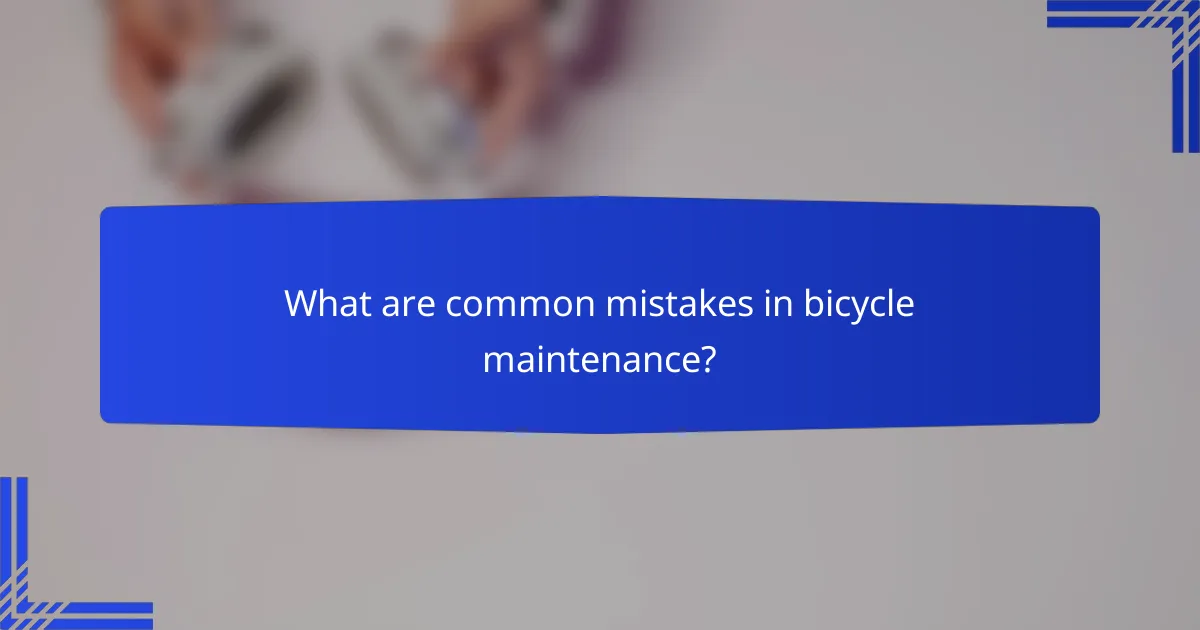Maintaining your bicycle involves regular cleaning, proper lubrication, and appropriate storage to ensure its longevity and performance. In New Zealand’s varied weather, consistent cleaning is crucial to prevent wear and tear. Additionally, using the right lubricant and knowing when to apply it can significantly enhance your bike’s efficiency. Finally, choosing the right storage solutions will protect your bike from potential damage, keeping it in top condition for your rides.

How to clean a bicycle in New Zealand?
To clean a bicycle in New Zealand, start by gathering the right materials and choosing a suitable location. Regular cleaning helps maintain performance and prolongs the life of your bike, especially in New Zealand’s diverse weather conditions.
Using soap and water
Using soap and water is a straightforward method for cleaning your bicycle. Fill a bucket with warm water and add a mild detergent, ensuring it is safe for metal and paint. Use a sponge or cloth to wipe down the frame, wheels, and components.
Rinse thoroughly with clean water to remove any soap residue, which can attract dirt. Avoid using high-pressure hoses, as they can force water into bearings and other sensitive areas.
Using a degreaser
A degreaser is essential for cleaning the drivetrain, including the chain, cassette, and derailleur. Apply a degreaser specifically designed for bicycles, allowing it to sit for a few minutes to break down grime. Use a brush to scrub away stubborn dirt.
After scrubbing, rinse the degreaser off with water. It’s advisable to degrease your bike every few weeks, especially if you ride frequently or in muddy conditions.
Cleaning tools and brushes
Invest in a few essential cleaning tools to make the process easier. A soft brush is ideal for delicate areas, while a stiff brush can tackle tougher grime on the tires and frame. A chain cleaning tool can simplify the process of cleaning the chain effectively.
Microfiber cloths are great for drying and polishing your bike after cleaning. Ensure all tools are clean before use to avoid transferring dirt back onto the bike.
Frequency of cleaning
The frequency of cleaning your bicycle depends on usage and conditions. For regular riders, a thorough clean every two to four weeks is recommended, while casual riders may clean less often. After riding in wet or muddy conditions, a quick wash is advisable.
Pay attention to the drivetrain, as it may require more frequent cleaning to maintain optimal performance. Regular maintenance not only keeps your bike looking good but also enhances its longevity.

What are the best lubrication techniques for bicycles?
The best lubrication techniques for bicycles involve selecting the right type of lubricant, applying it correctly, and knowing when to reapply. Proper lubrication reduces friction, extends the lifespan of components, and enhances overall performance.
Types of bicycle lubricants
Bicycle lubricants generally fall into two categories: wet and dry lubricants. Wet lubricants are ideal for wet or muddy conditions as they resist water but can attract dirt. Dry lubricants, on the other hand, are better for dry and dusty environments, as they leave a cleaner finish and attract less grime.
Common types of lubricants include oil-based, wax-based, and ceramic lubricants. Oil-based options provide good penetration and protection, while wax-based options create a dry, clean surface. Ceramic lubricants offer advanced protection and durability, often at a higher price point.
How to apply lubricant
To apply lubricant effectively, start by cleaning the chain and components thoroughly to remove dirt and old lubricant. Once clean, apply a small amount of lubricant directly to the chain while pedaling backward to ensure even distribution.
After application, allow the lubricant to penetrate for a few minutes, then wipe off any excess with a clean cloth. This prevents dirt accumulation and ensures optimal performance. Avoid over-lubricating, as this can lead to a buildup of grime.
When to lubricate
Lubrication frequency depends on riding conditions and mileage. A general rule is to lubricate your bike chain every 100-200 kilometers or after riding in wet or muddy conditions. Regular checks can help maintain optimal performance.
Signs that your bike needs lubrication include a squeaky chain, visible rust, or a dry appearance. Keeping a maintenance log can help track when lubrication is due, ensuring your bicycle remains in top condition.

How to store a bicycle properly?
Proper bicycle storage is essential to maintain its condition and longevity. Whether indoors or outdoors, the right storage solutions can protect your bike from damage and wear.
Indoor storage solutions
Indoor storage is ideal for protecting your bicycle from the elements. Consider using a wall-mounted rack or a freestanding bike stand to keep your bike upright and secure.
Additionally, storing your bike in a climate-controlled environment can prevent rust and deterioration. If space is limited, vertical storage solutions can maximize your area while keeping the bike accessible.
Outdoor storage options
When outdoor storage is necessary, choose a location that is sheltered from direct sunlight and rain. A bike shed or a covered porch can provide adequate protection against weather conditions.
Using a sturdy lock is crucial for outdoor storage to prevent theft. Opt for a high-quality U-lock or chain lock, and secure both the frame and wheels to an immovable object.
Protective covers and accessories
Investing in a protective cover can significantly extend the life of your bicycle when stored outdoors. Look for covers made from waterproof and UV-resistant materials to shield your bike from moisture and sun damage.
Other accessories, such as wheel locks and frame locks, can enhance security. Regularly check your storage setup to ensure it remains effective and make adjustments as needed for optimal protection.

What are the benefits of regular bicycle maintenance?
Regular bicycle maintenance significantly enhances performance and extends the lifespan of your bike. By keeping your bike clean, lubricated, and properly stored, you can ensure a smoother ride and reduce the likelihood of costly repairs.
Improved performance
Regular maintenance leads to better bike performance by ensuring that all components function optimally. Clean chains, properly inflated tires, and adjusted brakes contribute to a more efficient ride, allowing you to pedal with less effort and enjoy a smoother experience.
To maintain performance, check your tire pressure weekly and clean your chain after every few rides, especially if you ride in wet or muddy conditions. Regularly lubricating moving parts can also prevent wear and tear, keeping your bike responsive.
Extended lifespan
Proper maintenance can significantly extend the lifespan of your bicycle. By addressing minor issues before they escalate into major problems, you can avoid costly repairs and replacements. Regular cleaning and lubrication help prevent rust and corrosion, which can damage components over time.
Consider performing a thorough inspection every few months, focusing on the frame, brakes, and gears. Additionally, storing your bike indoors or in a dry place can protect it from weather-related damage, further prolonging its life.

What tools are essential for bicycle maintenance?
Essential tools for bicycle maintenance include multi-tools, cleaning kits, and lubrication tools. These items help ensure your bike remains in optimal condition, enhancing performance and longevity.
Multi-tools
A multi-tool is a compact device that combines various tools into one, making it ideal for on-the-go repairs. Look for models that include screwdrivers, wrenches, and tire levers, as these are commonly needed for adjustments and fixes.
When selecting a multi-tool, consider the weight and size, especially if you plan to carry it during rides. A good multi-tool should fit easily in your pocket or bike bag without adding significant bulk.
Cleaning kits
Cleaning kits typically include brushes, sponges, and biodegradable soap designed specifically for bicycles. Regular cleaning helps prevent dirt buildup that can damage components and affect performance.
Choose a cleaning kit that suits your bike type, whether it’s a road bike or mountain bike. Look for kits that offer degreasers for the chain and other moving parts, as well as protective sprays to keep surfaces shiny and rust-free.
Lubrication tools
Lubrication tools are essential for maintaining smooth operation of your bike’s moving parts, such as the chain, gears, and brakes. Use high-quality bike-specific lubricants to reduce friction and wear.
Apply lubricant sparingly and wipe off any excess to prevent dirt attraction. Regular lubrication intervals depend on riding conditions; for instance, wet or muddy conditions may require more frequent applications compared to dry environments.

What are common mistakes in bicycle maintenance?
Common mistakes in bicycle maintenance include neglecting regular cleaning, improper lubrication, and inadequate storage. These errors can lead to decreased performance, increased wear, and potential safety hazards.
Neglecting regular cleaning
Failing to clean your bicycle regularly can result in dirt and grime buildup, which may damage components over time. Aim to clean your bike after every few rides, especially if you’ve been on muddy or wet trails.
Use a gentle soap and water solution to wash the frame, wheels, and drivetrain. Avoid high-pressure water, as it can force dirt into bearings and other sensitive areas.
Improper lubrication
Using the wrong type of lubricant or applying it excessively can lead to poor performance and component failure. It’s essential to choose a lubricant designed for bicycles, such as wet or dry lube, depending on the riding conditions.
Apply lubricant sparingly to the chain and other moving parts, wiping off any excess to prevent attracting dirt. Regularly check and reapply lubrication, especially after wet rides.
Inadequate storage
Storing your bicycle improperly can expose it to elements that cause rust and deterioration. Ideally, keep your bike in a dry, temperature-controlled environment, away from direct sunlight and moisture.
If you must store it outside, consider using a waterproof cover and locking it securely. Regularly check for signs of wear or damage during storage to ensure it’s ready for your next ride.
